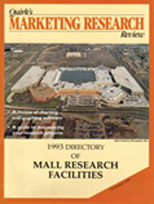Editor's note: Tony Siciliano is managing director of International Interviewing, New York, a service of Michael Amoroso Inc.
There was a mild flurry of interest in the tachistoscope some years ago and I had spent several years working with Seymour Smith (of Seymour Smith Associates), one of the pioneers of T-Scope techniques.
The tachistoscope, or T-Scope, is a slide projector with a timing device. It allows visual stimuli to be exposed at very fast and consistently accurate speeds. It was first used by psychologists and physiologists to measure visual acuity. The device was used during World War II to train military personnel to quickly identify enemy aircraft. This was Seymour Smith's first experience with the tachistoscope and he saw its potential for testing packaging and print advertising.
When I left the Smith organization, I moved to France to concentrate on providing research capabilities for American companies interested in European markets. Much to my surprise, the European clients of the French market research agency where I worked were keenly interested in the T-Scope techniques for testing packaging, which I thought were part of my past.
It turned out that advertising and design staffs in Europe have a great deal of clout in research decisions that assess their creative endeavors. Below is the English translation of an article I wrote for a French market research journal, which demonstrates why the T-scope techniques were readily accepted in Europe.
The major complaint creative people hurl at market research is its essentially negative orientation. These artists and writers feel their work is the life-blood of marketing. Market research looms as a sentinel poised to challenge, confuse or deride their creative output. In many cases these complaints are justified. All too often, packaging research will only tell if something is bad, with no indication about why. Very rarely does it provide direction for improvement.
I have spent many years working with T-Scope packaging- testing techniques that both management and creative staffs are happy with. The reason for this consensus lies in the diagnostic data these methodologies generate. It's rare that a package is totally bad and this is what infuriates creative people when they see research that seems to condemn their efforts wholesale. They intuitively know this is not an honest assessment. A package is composed of several elements and if a problem does exist, it's usually because of one or two elements.
The tachistoscopic techniques under discussion analyze the individual elements that make up packages. This is made possible by the T-Scope's brief, precision-timed exposures, which isolate these elements.
The packaging technique, which we call "the elemental series," breaks a package into three components:
- the first "elemental" viewing shows the packaging graphics/colors, but no product or brand information;
- the second "elemental" viewing adds the product information;
- the third "elemental" viewing adds brand information, to complete the package.
Each of these elements is probed on perception and imagery. There are also mass display measurements where the test package appears with competitive brands in an in-shelf display. These measurements indicate how well a package performs under real conditions.
The best way to demonstrate these techniques is to cite some actual case histories. We'll begin with the infant's toiletry package that led to the development of the elemental series. In the early days of tachistoscopic testing, a complete package was shown at a high speed and respondents were asked to draw pictures of what they saw. The product was a cotton-tipped stick used to clean infants' ears and eyes. The new package design had these cotton sticks arranged in a cross-bow fashion.
We found when women drew this design and were unaware of the brand (a leader in infant-care products), they would interpret it as something "poisonous," "dangerous," "to be kept away from children." Women who drew this design but knew the brand did not have these associations.
We realized from these findings that brand perception could be a serious impediment to analyzing a new package's performance. If respondents knew a new package was for a well-known and respected manufacturer, problems were unlikely to emerge. We also realized that each element in a package was projecting something on its own and we should maximize conditions for each element's associations. This led to the development of the elemental series, where gradually building a package shows us how each component contributes to perception, product/brand associations and attitudinal imagery.
Our next case history took place in France. A client wanted to improve the imagery of his fruit beverage brand by changing its geometric-design label to one with outdoor scenery, including trees, mountains and grass.
The elemental series showed the new illustration was unnatural - the trees in particular were too symmetrical and looked unreal; the illustration was cluttered by too many elements, and these elements were projecting dairy products more than a beverage. Minor revisions in the illustration, deleting confusing and cluttering elements, and replacing symmetrical designs with natural artwork, resulted in a label that achieved the client's imagery goals with no in-shelf perception loss.
